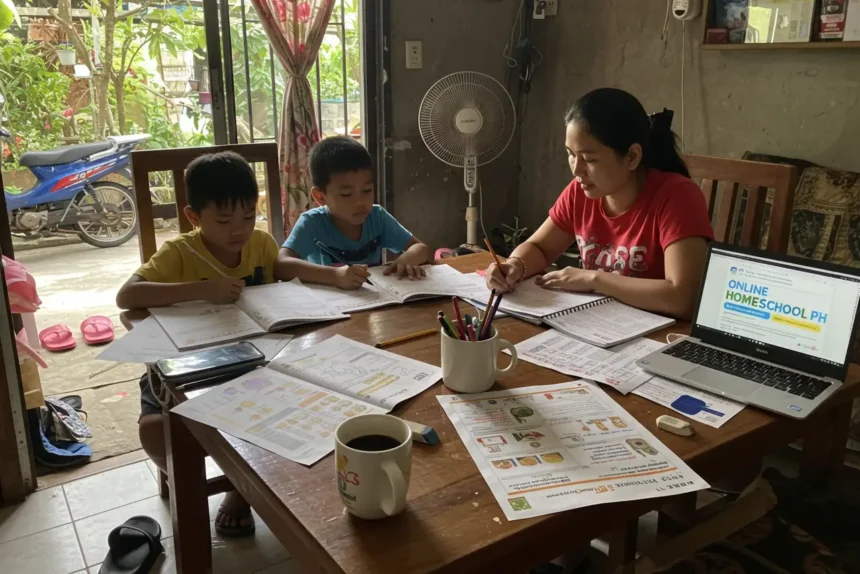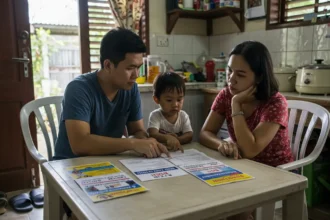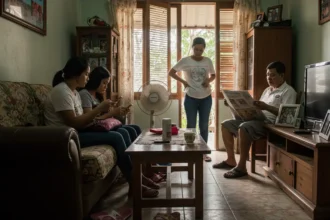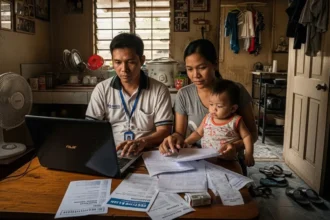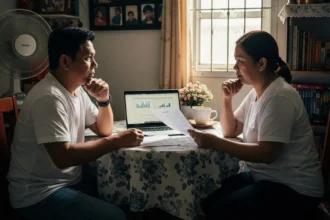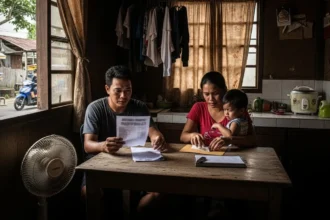Homeschooling in the Philippines has quietly grown from a niche choice into a mainstream option for many families. After the pandemic, more parents started asking: “Is there a better, safer, and more flexible way for my child to learn?” For some, the answer was homeschooling.
- ⚖️ Is Homeschooling Legal in the Philippines?
- 🎯 Step 1: Check Requirements & Commitments
- 📚 Step 2: Choose a Homeschool Method/Curriculum
- 🏡 Step 3: Set Up Your Homeschool Space and Schedule
- 📝 Step 4: Teach & Track Progress
- 📑 Step 5: Handle Legalities & Assessments
- 🤝 Socialization & Extracurriculars
- ⚖️ Pros and Cons of Homeschooling in the Philippines
- 🌟 Tips for Successful Homeschooling
- ❓ FAQs About Homeschooling in the Philippines
- 🚀 Homeschooling: A Brave and Rewarding Choice for Filipino Families
- 📚 References
Unlike before, when it seemed intimidating or even unusual, today’s Filipino parents have more support, resources, and communities to guide them. Whether it’s for safety, flexibility, or dissatisfaction with traditional schools, families are realizing that home education in the Philippines can be not only legal but also effective.
The best part? Parents don’t need to be licensed teachers to make it work. With dedication, patience, and the right resources, thousands of families are already proving that homeschooling in the Philippines can be both practical and rewarding.
⚖️ Is Homeschooling Legal in the Philippines?
The short answer is yes-homeschooling is legal in the Philippines, as long as families follow certain guidelines. The Department of Education (DepEd) recognizes homeschooling as a valid mode of learning, and parents have two main routes to choose from:
1. Enrolling with a DepEd-Accredited Homeschool Provider
These are private schools or organizations recognized by DepEd that offer homeschool programs. They provide a structured curriculum (usually aligned with the K–12 system), lesson guides, and official records like report cards. At the end of the year, your child is considered officially enrolled and can smoothly transition back to traditional school if needed.
-
Examples: Homeschool Global, Peniel, Catholic Filipino Academy (CFA).
-
Pros: Guidance, ready-made curriculum, official documents provided.
-
Cons: Comes with enrollment fees that can range from ₱20k–₱100k per year depending on inclusions.
2. Independent or DIY Homeschooling
Parents can choose to design their own curriculum without enrolling in a provider. This approach gives full freedom, but parents must ensure their children can still get accreditation later. Students under this path may need to take DepEd’s PEPT (Philippine Educational Placement Test) or join the ALS (Alternative Learning System) to be officially recognized for grade placement.
-
Pros: Flexible, often more affordable (some families spend only ₱5k–₱10k yearly on materials).
-
Cons: Requires more effort from parents to plan lessons, track progress, and handle assessments.
Assurance for Parents
Whether you go through a provider or independent route, your child can still obtain DepEd accreditation and eventually enter senior high school, college, or even study abroad. Many homeschool graduates in the Philippines have successfully passed entrance exams for top universities like UP, Ateneo, and La Salle.
Homeschooling isn’t a legal loophole-it’s a recognized alternative for Filipino families who want more control over their children’s education.
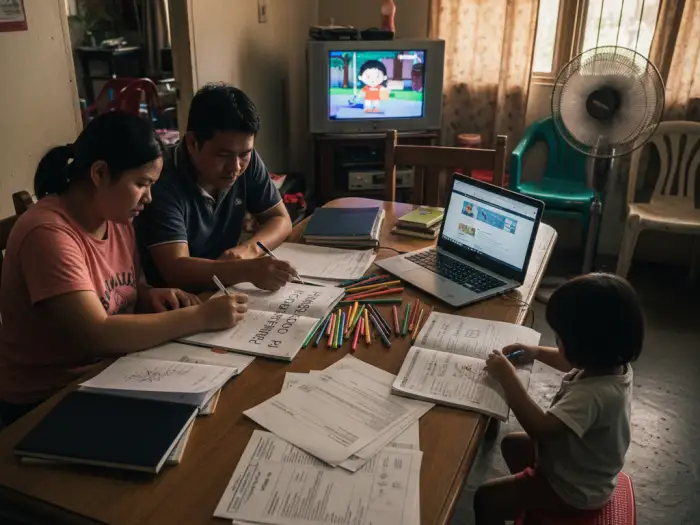
🎯 Step 1: Check Requirements & Commitments
Before diving into homeschooling in the Philippines, parents need to ask themselves: “Am I ready for this commitment?” Homeschooling isn’t just about pulling your child out of traditional school-it requires time, patience, and consistency.
What Parents Need to Know
-
No special degree required – Legally, parents don’t need to be licensed teachers. What matters most is your ability to guide, encourage, and stay consistent.
-
Time commitment – At least one parent (or a tutor) should be available daily to facilitate lessons. Homeschooling often takes 2–4 focused hours per day-shorter than a full school day but still requiring dedicated attention.
-
Cost considerations –
-
If you enroll in a DepEd-accredited homeschool provider, expect to pay tuition and enrollment fees, which vary depending on inclusions.
-
If you go independent, costs are lower-you’ll only need to budget for books, online resources, or materials.
-
The Parent’s Role
Think of yourself not just as a teacher, but also as a mentor and guide. Many parents worry about “not being good enough” to homeschool, but remember: you know your child better than anyone. With patience, creativity, and access to today’s resources, you can provide quality education at home.
Commitment Checklist
Before starting, ask yourself these questions:
-
Do I (or my spouse) have time daily to sit with my child for lessons?
-
Am I willing to adjust my schedule around my child’s learning pace?
-
Do we have a quiet, distraction-free corner for study at home?
-
Am I ready to log progress, exams, or portfolios as required by a provider or DepEd?
If you can confidently answer “yes” to most of these, then you’re ready to move forward with homeschooling in the Philippines.
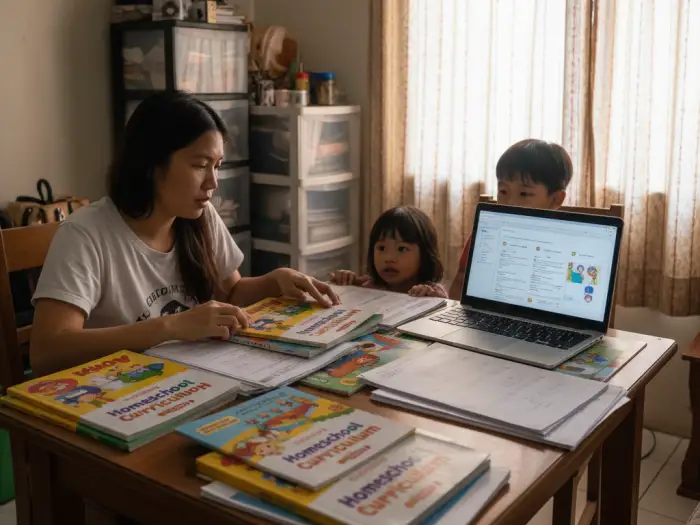
📚 Step 2: Choose a Homeschool Method/Curriculum
One of the first big decisions when starting homeschooling in the Philippines is figuring out how you’ll teach. Unlike traditional schools, homeschooling gives you flexibility to choose a method and curriculum that fits your child’s learning style and your family’s values.
Common Approaches to Homeschooling
Structured (School-at-Home)
This follows a classroom-style approach with daily schedules, textbooks, and exams. It works best for parents who prefer order and for kids who thrive on routine.
-
Pros: Easy to track progress, closer to traditional school.
-
Cons: Can feel rigid and tiring if done exactly like school.
Unschooling
A more flexible method where learning is child-led-less about textbooks, more about exploration. For example, if your child loves animals, you might build lessons around science experiments, documentaries, and trips to the zoo.
-
Pros: Highly personalized, encourages curiosity.
-
Cons: Can be challenging to align with DepEd standards if not monitored.
Eclectic or Blended
The most popular style among Filipino homeschoolers-mixing structured lessons (for subjects like Math and Filipino) with hands-on or interest-based learning for others (like arts or science experiments).
-
Pros: Balanced, adaptable, less stressful.
-
Cons: Requires planning from parents to combine resources.
Curriculum Options for Filipino Families
DepEd Curriculum
-
Based on the official K–12 competencies, which are available for free on the DepEd website.
-
Great for parents who want their child’s lessons aligned with public/private schools in case of re-enrollment.
Faith-Based Curriculum
-
Offered by providers like Catholic Filipino Academy (CFA) or other Christian organizations.
-
Combines academics with values and faith-based instruction.
-
Ideal for families who want religion integrated into daily lessons.
International or Alternative Programs
-
Some homeschool providers use international programs such as U.S.-based or Montessori curricula.
-
These can be adapted to the Filipino context by adding required subjects like Filipino language and Araling Panlipunan.
-
Perfect for families considering overseas studies or expat lifestyles.
Core Subjects to Prioritize
No matter which curriculum you choose, make sure to cover the essentials so your child doesn’t fall behind:
-
English
-
Math
-
Science
-
Filipino
-
Araling Panlipunan (AP)
Covering these ensures that if your child returns to traditional school or takes a PEPT/ALS exam, they’ll be on track with their peers.
🏡 Step 3: Set Up Your Homeschool Space and Schedule
You don’t need a big house or a fancy study room to start homeschooling in the Philippines. What matters most is creating an environment that helps your child focus and making a routine that works for your family’s lifestyle.
Creating a Learning Space
-
Dedicated corner or table – A simple desk with good lighting is enough. Some families use a part of the dining table or a small study nook.
-
Minimize distractions – Position the study area away from the TV, gaming consoles, or noisy areas of the house.
-
Organize materials – Keep books, notebooks, and supplies in one spot (shelves, boxes, or a rolling cart). This avoids wasting time looking for things.
-
Pinoy tip: If space is tight, a portable “homeschool box” (a plastic drawer or container) with all essentials works well-just pull it out during study time.
Building a Daily Routine
Unlike traditional schools, homeschooling doesn’t have to be eight hours long. Most families find that 2–4 focused hours of study per day is enough since one-on-one learning is more efficient.
-
Morning sessions – Many homeschool families tackle core subjects (Math, English, Science) before lunch, when kids are most alert.
-
Afternoons for creativity – Reserve time for art, music, sports, or outdoor play. Learning isn’t limited to books.
-
Flexible pacing – If your child struggles with Math but loves Science, you can adjust time spent on each subject.
Socialization and Community
One of the biggest concerns about homeschooling is, “What about social skills?” The good news is there are many ways to keep kids socially active:
-
Homeschool co-ops – Families often form groups in cities like Manila, Cebu, and Davao for shared lessons, science experiments, and group projects.
-
Extracurriculars – Enroll your child in barangay sports leagues, church youth groups, or community art classes.
-
Field trips – Many homeschool groups organize museum visits, nature walks, or cultural trips so kids can learn outside the home.
Homeschooling gives you the flexibility to match learning to your family’s lifestyle-whether that means doing Math in the morning, gardening in the afternoon, or joining a community trip on weekends.
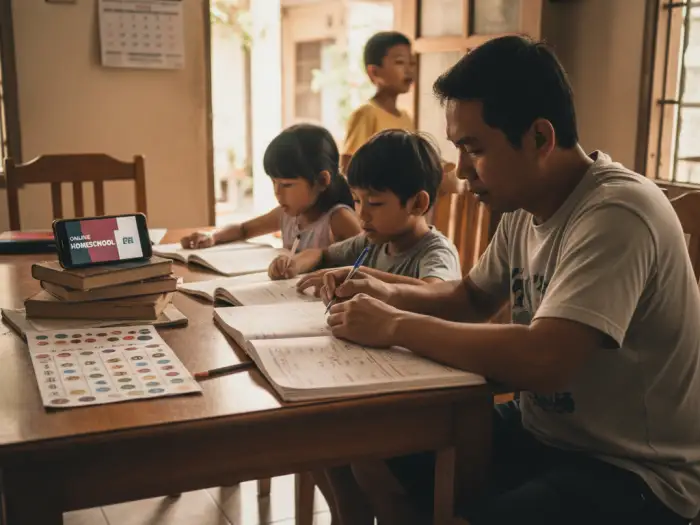
📝 Step 4: Teach & Track Progress
Once your homeschool setup is ready, the real journey begins-teaching your child and making sure they’re learning at the right pace. Don’t worry, you don’t need to copy a traditional school classroom. Homeschooling is flexible, and there are many ways to make learning effective and even fun.
Teaching Tips for Parents
-
Use real-life examples – Math can be taught while cooking (fractions in measuring ingredients), Science during gardening (photosynthesis through planting kamatis), and budgeting at the palengke (basic addition and subtraction). Everyday Pinoy life can be your classroom.
-
Keep lessons interactive – Use stories, songs, or even Filipino games (like “tumbang preso” for physics concepts or “sungka” for math skills).
-
Be patient and encouraging – The first few weeks may feel rocky as you and your child adjust. Remember, homeschooling doesn’t need to mirror 8 hours of school; 2–4 focused hours can achieve more than a full school day.
-
Incorporate technology – Educational YouTube channels, apps like Khan Academy, and even Pinoy homeschooling Facebook groups offer free resources.
Tracking Progress
It’s important to document what your child is learning, especially if you plan to transition back to traditional school or comply with DepEd requirements.
-
Daily/weekly logs – Write down lessons completed, books read, or skills practiced.
-
Portfolio system – Keep samples of your child’s work: essays, math worksheets, science projects, or photos of art pieces. This becomes a record of their growth.
-
Provider requirements – If you’re under a homeschool provider, they may require periodic tests, quizzes, or portfolio submissions.
-
Independent homeschoolers – Keep detailed records in case your child needs to take the PEPT (Philippine Educational Placement Test) or ALS accreditation exams later.
How Much Time to Teach Daily?
Most Filipino homeschool parents find that:
-
Preschool/Grades 1–3: 1.5–2 hours a day is enough.
-
Grades 4–6: 2–3 hours a day.
-
High School: 3–5 hours a day, depending on subjects.
Remember: quality > quantity. Because it’s one-on-one, you cover more in less time compared to traditional classrooms.
Encouraging Lifelong Learning
Homeschooling isn’t just about textbooks. Encourage your child to pursue personal interests-whether that’s drawing, coding, cooking, or sports. These passions often turn into valuable skills later in life.
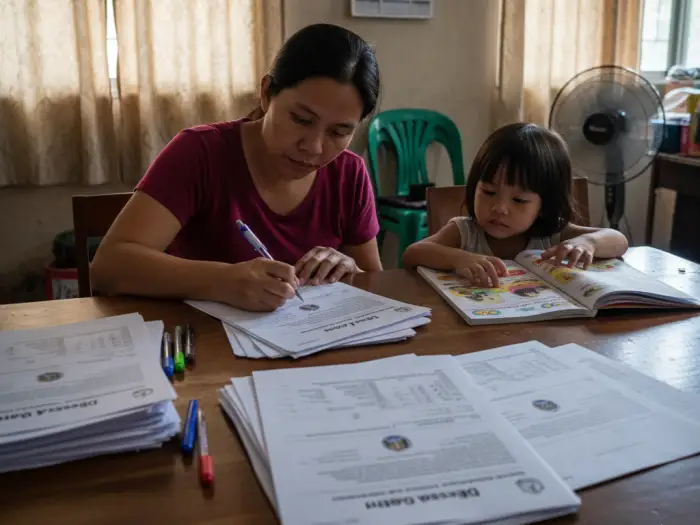
📑 Step 5: Handle Legalities & Assessments
One of the most important parts of homeschooling in the Philippines is making sure your child’s education is properly recognized by the Department of Education (DepEd). This ensures that if your child transitions back to traditional school, enters senior high school, or applies for college, their learning will be accredited.
If You’re With a Homeschool Provider
-
Accreditation: Most DepEd-accredited providers handle the paperwork and ensure that your child’s records (grades, report cards, certificates) are valid.
-
Assessments: Providers usually administer their own tests, portfolio checks, or quarterly exams to measure progress.
-
Peace of mind: Since they issue official school documents, re-enrolling in a regular school later is smoother.
If You’re Independent (DIY)
-
PEPT (Philippine Educational Placement Test): Administered by DepEd for students who need grade-level placement. Many homeschoolers take this exam around Grades 6, 10, or 12 to validate their learning.
-
ALS (Alternative Learning System): Another DepEd-recognized program that allows homeschoolers to gain certificates equivalent to grade levels. ALS learners often take the A&E (Accreditation & Equivalency) Test.
-
Registration with DepEd: While not mandatory for DIY homeschoolers, some parents write a Letter of Intent to their local DepEd division office for documentation and peace of mind.
What to Prepare for Assessments
-
Portfolio of Work: Keep samples of assignments, quizzes, projects, and reading logs.
-
Daily/Weekly Logs: Helps show consistency in learning.
-
Core Subjects Coverage: Ensure your child has studied English, Math, Science, Filipino, and Araling Panlipunan (AP), as these are standard in validation exams.
Reassurance for Parents
It may sound intimidating, but thousands of Filipino homeschool families have successfully navigated PEPT and ALS requirements. With proper preparation and record-keeping, your child can earn DepEd-recognized certificates and continue to higher education without issue.
Homeschooling isn’t a “shortcut”-it’s a recognized path that simply gives families more freedom to choose how learning happens.

🤝 Socialization & Extracurriculars
One of the most common questions parents ask is: “If my child is homeschooled, how will they learn social skills?” It’s a valid concern, but the truth is that homeschooling in the Philippines doesn’t mean isolation. In fact, with intentional effort, homeschooled kids can have rich social experiences both inside and outside the home.
Co-ops and Homeschool Groups
Many Filipino families form homeschool co-ops-small groups where parents and kids meet weekly for shared lessons, science experiments, art activities, or even field trips. These co-ops provide academic support while allowing children to make friends and work in teams.
-
In Metro Manila, Cebu, and Davao, there are active groups that organize regular meet-ups.
-
Facebook groups like Homeschoolers of the Philippines often post about events, workshops, and online forums for parents and students.
Extracurricular Activities
-
Sports: Kids can join barangay basketball leagues, swimming classes, martial arts, or dance studios.
-
Arts: Music lessons, painting workshops, or theater groups are popular options that also build confidence.
-
Church/Community Groups: Youth groups, choir, or outreach programs help kids connect with peers while developing values.
Family and Sibling Bonding
Homeschooling often strengthens family relationships. Siblings can study some subjects together, fostering teamwork. Cousins or neighbors can join certain activities too, giving kids a mix of familiar and new interactions.
Field Trips and Real-World Learning
Traditional schools organize field trips once or twice a year-homeschoolers can do them more often. Visits to museums, historical sites, farms, or even grocery stores become opportunities for learning and socialization. Some homeschool families even coordinate “Homeschool Day Out” events, like group science fairs or Christmas programs.
The Key to Socialization in Homeschooling
Social growth doesn’t happen by accident-it happens by parental initiative. As long as parents are proactive in enrolling kids in community activities and encouraging friendships, homeschoolers can be just as socially adept (if not more) than their traditionally schooled peers.
⚖️ Pros and Cons of Homeschooling in the Philippines
Homeschooling isn’t for everyone, but it’s an option worth exploring. To help you decide, here’s a clear look at the benefits and challenges Filipino families often face when choosing home education in the Philippines.
✅ Pros
-
Individualized Learning – Kids can move faster in subjects they excel at (like Math or Reading) and take more time with subjects they struggle with.
-
Flexible Schedule – Perfect for families who travel, or for kids pursuing sports, arts, or other special interests. Learning doesn’t have to follow the 7 AM–4 PM school routine.
-
Closer Family Bonding – Parents spend more time with their children, which often leads to stronger family relationships.
-
Values Integration – Parents can integrate Filipino values, family traditions, or faith-based lessons into daily education.
-
Less Stressful Environment – Children learn at home, free from peer pressure, bullying, or long commutes.
❌ Cons
-
Time-Intensive for Parents – At least one parent must dedicate a big chunk of their day to teaching, which can feel like a full-time job.
-
Cost of Materials/Providers – Independent homeschooling can be affordable, but enrolling in providers may cost ₱20k–₱100k+ per year.
-
Limited Facilities – Science labs, gyms, or extracurricular clubs found in schools aren’t always available at home. Parents need creative alternatives.
-
Patience Required – Being both parent and teacher can blur boundaries. Kids may test limits, and parents need to learn how to balance discipline with encouragement.
-
Socialization Requires Effort – Unlike in traditional schools, parents must actively arrange for social activities, sports, and group learning.
📊 Quick Glance: Homeschool vs. Traditional School
| Aspect | Homeschooling | Traditional School |
|---|---|---|
| Schedule | Flexible, family-controlled | Fixed, 7 AM–4 PM |
| Learning Pace | Child-centered | Class-centered |
| Socialization | Requires parent initiative | Built-in daily peer interaction |
| Costs | Ranges ₱5k–₱100k+ | Tuition fees + school expenses |
| Environment | Home-based, personalized | Classroom, standardized |
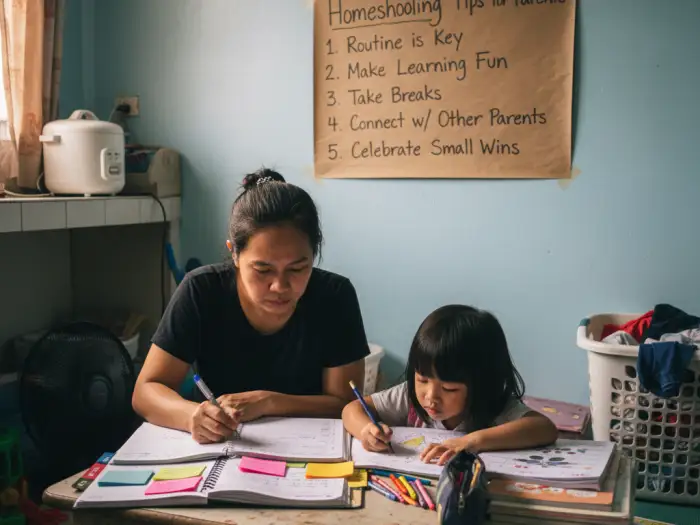
🌟 Tips for Successful Homeschooling
Starting your homeschooling journey is exciting-but it also comes with challenges. To make the transition smoother, here are some tried-and-tested homeschooling tips for parents in the Philippines:
Connect With Other Homeschool Families
-
Join Facebook groups like Homeschoolers of the Philippines or local co-ops in your city.
-
Veteran homeschool parents are generous with advice and resources-whether it’s about choosing books, handling PEPT exams, or planning field trips.
-
Building a network also helps with socialization opportunities for your kids.
Customize Learning to Your Child
-
Don’t be afraid to adapt lessons to your child’s interests. If they love insects, turn it into a Science project. If they’re into basketball, use it to explain Math concepts like percentages and averages.
-
Homeschooling gives you the freedom to teach beyond textbooks-make learning exciting and relevant.
Avoid “School at Home” Burnout
-
Homeschooling doesn’t need to copy the 8-hour traditional school schedule. Most families accomplish core lessons in 2–4 focused hours per day.
-
Use the rest of the day for life skills: cooking (Math, Science), gardening (Biology), or even budgeting at the palengke (Practical Math).
Use Free & Affordable Resources
-
DepEd Modules & MELCs – Download the K–12 learning competencies directly from DepEd’s website.
-
Online platforms – Khan Academy, YouTube EDU, and even local sites offer free lessons.
-
Second-hand books – Many homeschool parents sell pre-loved textbooks at affordable prices in online groups.
Celebrate Small Wins
-
Progress may feel slow some days, but every completed lesson, project, or skill learned is an achievement.
-
Celebrate milestones with a family outing, a simple treat, or by showcasing your child’s work to relatives. Encouragement fuels motivation-for both child and parent.
Stay Flexible and Patient
-
Some weeks will go smoothly, others may feel overwhelming. Don’t panic-flexibility is one of homeschooling’s biggest strengths.
-
Remember: your role is not to replicate a strict teacher, but to guide and nurture your child’s love for learning.
❓ FAQs About Homeschooling in the Philippines
1. Is homeschooling legal in the Philippines?
Yes. The Department of Education (DepEd) recognizes homeschooling through accredited providers or independent homeschooling. Both routes can lead to official accreditation via PEPT or ALS exams.
2. Do I need to be a licensed teacher to homeschool my child?
No. Parents don’t need teaching licenses, though patience, time, and dedication are required. A TESOL/TEFL or education background helps, but it isn’t mandatory.
3. How much does homeschooling cost?
Independent homeschooling can cost as little as ₱5k–₱10k per year using free DepEd modules and second-hand books. Providers may charge ₱20k–₱100k+ depending on inclusions like books, LMS access, and teacher consultations.
4. Can my child go back to traditional school after homeschooling?
Yes. If enrolled under a provider, report cards make re-entry easier. Independent homeschoolers may need to take validation exams like PEPT to determine grade placement.
5. What curriculum should we follow?
You can use DepEd’s K–12 curriculum, faith-based programs (e.g., Catholic Filipino Academy), or international options like U.S.-based or Montessori methods. Just ensure Filipino, AP (Araling Panlipunan), and other local subjects are covered.
6. How many hours a day does homeschooling take?
Usually 2–4 hours of focused lessons are enough for most grade levels. Older students may need 3–5 hours, but this is still shorter than the traditional 8-hour school day.
7. What about socialization for my child?
Homeschoolers socialize through co-ops, community sports, art or music classes, church youth groups, and field trips. With parental initiative, they often develop strong social skills.
8. Do I need to inform DepEd if I homeschool independently?
Not strictly, but many parents write a letter of intent to their local DepEd office for documentation. For official recognition later, your child may take PEPT or ALS exams.
9. Can homeschooling be done online?
Yes. Some providers offer full online programs with live or recorded classes. Independent families can also use online platforms like Khan Academy, YouTube EDU, or Filipino homeschool support sites.
10. What if I feel overwhelmed as a parent-teacher?
It’s normal! Join homeschool groups for support, take breaks, and remember learning doesn’t have to look like a classroom. Focus on progress, not perfection-flexibility is part of the journey.
🚀 Homeschooling: A Brave and Rewarding Choice for Filipino Families
Choosing to homeschool is not just about academics-it’s about giving your child a personalized, values-driven, and flexible education. While it takes effort, patience, and commitment, countless Filipino families have discovered that homeschooling allows kids to thrive both in learning and in life.
Whether you choose a DepEd-accredited provider or take the independent path, remember that homeschooling in the Philippines is legal, doable, and increasingly supported by communities nationwide. More than just textbooks and tests, it’s a chance to strengthen family bonds, nurture your child’s unique strengths, and create a less stressful learning environment.
So if you’ve been thinking about it, maybe this is the year to give homeschooling a try. Who knows? That small step today could be the start of a more meaningful and rewarding education journey for your family.
📚 References
-
Revised Policy Guidelines on Home Schooling Program – Department of Education
-
DepEd strengthens Homeschooling Program implementation – Department of Education
-
Philippine Educational Placement Test (PEPT) – Department of Education
-
Alternative Learning System (ALS) – Department of Education+1
-
Homeschooling in the Philippines: Parents’ Guide – Globe Telecom
-
Homeschool Global – Partner Schools & DepEd Accreditation – ph.homeschoolglobal.com
-
From Independent to DepEd Accredited Homeschooling – petitemomma.com
-
About the Program: Homeschooling Program PDF – depedncr.com.ph
-
Home Schooling Legal Status in the Philippines – HSLDA
-
ALS Certificate or ALS / PEPT Certificate (FOI request) – foi.gov.ph



